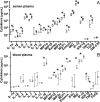Semen of HIV-1-infected individuals: local shedding of herpesviruses and reprogrammed cytokine network
- PMID: 22107749
- PMCID: PMC3242745
- DOI: 10.1093/infdis/jir700
Semen of HIV-1-infected individuals: local shedding of herpesviruses and reprogrammed cytokine network
Abstract
Background: Semen is the main carrier of sexually transmitted viruses, including human immunodeficiency virus type 1 (HIV-1). However, semen is not just a mere passive transporter of virions but also plays an active role in HIV-1 transmission through cytokines and other biological factors.
Methods: To study the relationship between viruses and the chemokine-cytokine network in the male genital tract, we measured the concentrations of 21 cytokines/chemokines and the loads of HIV-1 and of 6 herpesviruses in seminal and blood plasma from HIV-1-infected and HIV-uninfected men.
Results: We found that (1) semen is enriched in cytokines and chemokines that play key roles in HIV-1 infection or transmission; (2) HIV-1 infection changes the chemokine-cytokine network in semen, further enriching it in cytokines that modulate its replication; (3) HIV-1 infection is associated with Epstein-Barr virus (EBV) and cytomegalovirus (CMV) compartmentalized seminal reactivation; (4) CMV and EBV concomitant seminal shedding is associated with higher HIV-1 loads in blood and seminal plasma; and (5) CMV seminal reactivation increases the seminal levels of the CCR5 ligands RANTES and eotaxin, and of the CXCR3 ligand monokine induced by gamma interferon (MIG).
Conclusions: HIV-1 infection results in an aberrant production of cytokines and reactivation of EBV and CMV that further changes the seminal cytokine network. The altered seminal milieu in HIV-1 infection may be a determinant of HIV-1 sexual transmission.
Figures





References
-
- Owen DH, Katz DF. A review of the physical and chemical properties of human semen and the formulation of a semen simulant. J Androl. 2005;26:459–69. - PubMed
-
- Politch JA, Tucker L, Bowman FP, Anderson DJ. Concentrations and significance of cytokines and other immunologic factors in semen of healthy fertile men. Hum Reprod. 2007;22:2928–35. - PubMed
-
- Robertson SA, Ingman WV, O'Leary S, Sharkey DJ, Tremellen KP. Transforming growth factor beta–a mediator of immune deviation in seminal plasma. J Reprod Immunol. 2002;57:109–28. - PubMed
Publication types
MeSH terms
Substances
Grants and funding
LinkOut - more resources
Full Text Sources
Other Literature Sources
Research Materials

